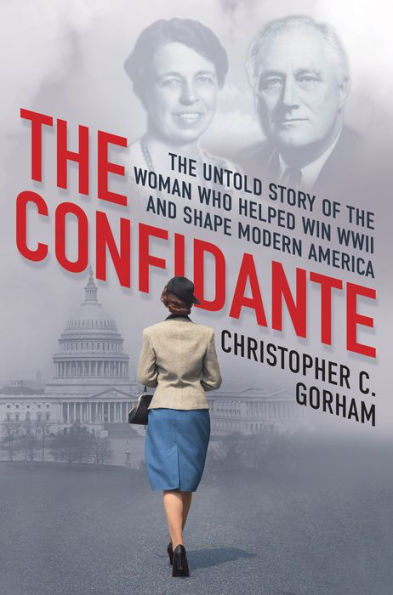The Confidante: The Untold Story of the Woman Who Helped Win WWII and Shape Modern America
- By Christopher C. Gorham
- Citadel
- 384 pp.
- Reviewed by C.B. Santore
- March 6, 2023
Meet a 20th-century trailblazer you’ve probably never heard of.

Anna M. Rosenberg was in the room. She was present at and played a part in some of the most momentous events of the 20th century, from the New Deal, World War II, and the Korean conflict to the presidency of Lyndon Johnson. Why have we not heard of her?
Christopher C. Gorham seeks to right that wrong in The Confidante: The Untold Story of the Woman Who Helped Win WWII and Shape Modern America. The title is no exaggeration. Rosenberg was awarded the Medal of Freedom, the Medal for Merit (the first woman to receive the honor), and the Eleanor Roosevelt Political and Public Service Award, testaments to her contributions. Gorham’s extensive use of primary sources and secondary works by historians provides ample additional evidence to support his title’s claim.
Rosenberg was born on the cusp of the 20th century into a middle-class family in Budapest. Her father sought to remake his life in America when he lost favor as furniture maker to the Austro-Hungarian emperor. After quickly re-establishing himself in New York, he sent for his wife and two daughters. Young Anna thrived there.
Early on, she demonstrated patriotism for her adopted country, a bent for activism, and an instinct for mediation, traits that would shape her life. Organizing charity events morphed into a lucrative public-relations business for Rosenberg. As her contact list grew, so did her celebrity and her reach. Among her clients was John D. Rockefeller; she successfully mediated a labor dispute for what would become Rockefeller Center.
As a woman in the 1920s, this was enough to make her notable. Her background in advocacy built trust with unions, while her pragmatism and business acumen scored points with management. These skills and her connections to the Democratic Party (an influential Tammany Hall boss was her political mentor) led to a position on the New Deal’s National Recovery Administration program in New York state. Her career in government was launched.
Rosenberg was tapped for successively weightier roles in Franklin D. Roosevelt’s administration. She became a confidante and senior advisor to the president, his go-to person for fixing difficult situations like quelling labor unrest. In the run-up to America’s entrance into the Second World War, building an arsenal was too important to risk work stoppages — despite the White House’s pro-labor leanings. Rosenberg became FDR’s eyes and ears on the front lines during the war, traveling to Europe to talk to GIs about what they needed and what they hoped for upon their return to civilian life.
Her rapport with the press, willingness to work long hours, and ability to charm generals, hard-nosed pols, and businessmen alike helped Rosenberg cut through red tape and get things done. Her list of achievements is staggering. She was involved in the behind-the-scenes negotiations for several significant policies, among them the GI Bill, Executive Order 9981 (desegregating the military), and the Civil Rights Act of 1964. She rose to the level of assistant secretary of defense in charge of procurement and personnel policy. She was one of the first civilians after liberation to enter Nazi concentration camps and to visit the Eagle’s Nest, a gathering place for Nazi party officials and the Führer himself.
Rosenberg’s ascendance and longevity as a political player are even more remarkable given that she was a Jewish immigrant who spoke in accented English and was known for advocating for social causes and women’s rights. Her work with labor unions also raised suspicions, and the unfortunate coincidence of her surname being the same as that of the notorious Ethel and Julius Rosenberg made her a target during the Red Scare. It appeared for a time that her nomination to be assistant secretary of defense would be scuttled by accusations of communist sympathies.
So how was she left out of the historical record for so long? My admittedly limited survey found only scant mention of her in books about the period; for example, she appears in a footnote in volume two of Truman’s memoirs and in a brief paragraph in David McCullough’s mammoth Truman. The fact that she was a woman could account for her failing to inspire a book until now, yet Francis Perkins, FDR’s secretary of labor, didn’t suffer the same fate, perhaps because she was Boston born and educated at elite U.S. schools. Rosenberg’s penchant for conducting business over the phone or in person rather than writing letters and memos may have hindered the historical record, too.
Gorham attributes the oversight in part to her reluctance to tout her own accomplishments, but despite her reserve, Rosenberg was once well known by the public. She ranked high in contemporaneous popularity polls and political-preference polls for governor of New York. And numerous articles about her were published in such periodicals as Time, Newsweek, U.S. News & World Report, and Fortune; they’re included in Gorham’s bibliography.
Whatever the reasons for overlooking this remarkable woman, The Confidante will enhance the library of anyone interested in 20th-century American history or women’s history. Anecdotes about Rosenberg and her experiences with famous acquaintances (like carpooling with Fiorello La Guardia), along with a competent chronicling of the period, make this valuable book both enjoyable and instructive.
C. B. Santore is a freelance writer and editor in East Hampton, CT.

